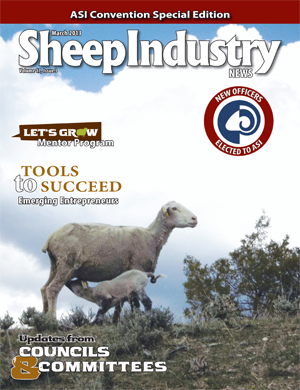
- March 2013
- Conaway Expresses Optimism on Farm Bill
- New Executive Board Members Elected to ASI
- President’s Notes
- ASI Elects New Officers
- I am Here to Work for You
- One Skin Type Can Not Make All Things
- Working to Reauthorize Livestock Mandatory Reporting
- Lamb Industry Assessment: Roadmap for the Industry
- Guns, Immigration, Fiscal Policies and Legacy Issues
- Re-Build Committee to Offer Funds for Mentor Program
- Bighorn Sheep and Disease Issues Cover at PERC Meeting
Lamb Industry Assessment:Roadmap for the Industry
By RON DAINES
Sheep Industry News Contributor
(March 1, 2013) The American Lamb Board (ALB) has hired the Boston-based Hale Group, a food and agribusiness consulting firm, to help chart a new roadmap to profitability.
The goal of the Lamb Industry Assessment Study is to identify and analyze the key challenges facing the industry and propose solutions and strategies for short- and long-term competitive advantages that will return the industry to consistent profitability.
Bob Ludwig, head of Hale Group, told the American Sheep Industry Association’s (ASI) Board of Directors in San Antonio that his group has considerable experience helping a wide variety of food industry entities with strategic planning. These include the National Restaurant Association and such commodity organizations as the National Cattlemen’s Beef Association, the U.S. Grain Council and the U.S. Meat Export Federation and such private companies as Starbucks, Sunkist and Tyson.
“This will be a roadmap for the whole industry,” Ludwig says. “I’m not interested in another study. Another study won’t solve your problems. We’ll be looking at agreements within the industry – consensus.”
Ludwig says the Hale Group will communicate with the industry in three ways:
- small group discussions to guide Hale Group as it assesses the industry and makes mid-course corrections;
- refine and improve input from the task force then conduct webinars, conference calls and updates to understand industry groups and to get feedback; and
- a lot of interaction – by phone and personal interview – to get input and insights from the industry.
The goal is to have the assessment study completed by August.
“We will provide an action plan for the next five years that you and ASI can address,” Ludwig says. “I would be very surprised if there were not active plans for every segment of this industry. Action plans for your participation.”
The timing of the assessment is critical as the lamb industry, coming off one of its worst years ever, faces several challenges. Nick Forrest, ALB chair, cited several, including drought, record high feed prices, increased import competition and decreased lamb purchases owing to high retail prices.
The assessment study is designed to help turn the lamb industry around and build on successes achieved in the 10 years the American Lamb Board (ALB) has been serving the industry.
Despite the 2012 setbacks, Forrest noted that ALB promotion has meant more lamb recipes and stories regularly featured year round in food magazines, an increased amount of lamb at retail and the variety of cuts being offered and American lamb now featured at national retailers like Kroger and Wal-Mart.
What’s more, Forrest said, new generations are experiencing lamb. The typical lamb user is now 35 to 50 years old compared with 55-75 years old 10 years ago.
Another trend upon which the American lamb industry is trying to capitalize is consumer focus on local, healthful and sustainably produced foods.
A year ago, ALB kicked off a sustainability study to identify best producer practices and lay a foundation for future improvements. The idea is to make the lamb industry more efficient and enhance the industry’s reputation.
A sustainability working group consisting of Cody Heimke, Leo Tammi, Clint Krebs, Dan Morrical and Tom Watson is working with Milepost Consulting. Janet Greenlee and Kenton Harmer of Milepost described their efforts, including a survey of producer practices.
Greenlee explained that Milepost conducted 19 onsite visits with producers and feeders representing different production systems and geographies. And it conducted a benchmark survey that garnered 1,113 responses representing nearly 1.49 million head of sheep and lambs. The survey covered such subjects as manure management, stewardship, grazing, animal husbandry, carbon emissions, animal handling, predation, employment practices and community relations.
Kenton said the survey uncovered the commitment by a large number of producers that utilize practices that protect the environment, improve land management, maintain animal well-being and generate positive social and economic impacts on local communities.
“It identified practices that can make the industry more efficient and enhance its reputation,” he says, and it identified risks and vulnerabilities along with areas for improvement.
The results of the study presented several opportunities for immediate communications, says Greenlee, including:
- that nearly all respondents said they monitor pastures for optimum grazing conditions;
- that 86 percent use at least three identified best practices to make their flocks comfortable;
- that respondents spent, on average, 86 percent of their operational budgets locally;
- and that 76 percent engage in community service, averaging 116 volunteer hours a year.
“The study provided some bright spots and some areas for improvement,” says Kenton. “The key is that retailers and customers don’t need you to be perfect. Get the right coalition together and take this on strategically.”

